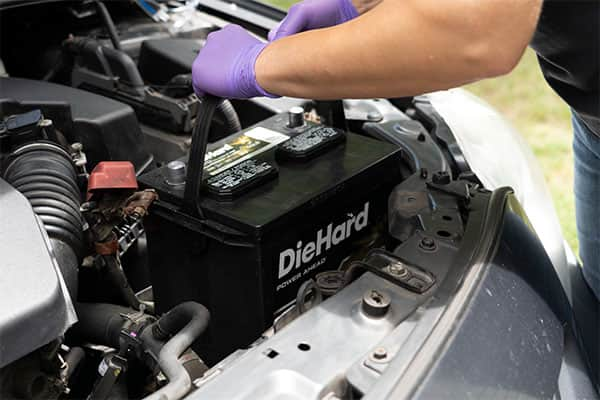Holiday road trips can make awesome memories that last a lifetime. They are also often massive disasters that get lots of laughs in holiday-themed comedies. The difference, as your cousin with the broken-down RV can tell you, is in your road trip prep. There's lots to do before setting out on a cross-country road trip, but most of it is easy.
Here's everything you need to make sure you're the one laughing as you save the holidays.

Source | Getty
How to Plan a Road Trip
The absolute first thing, before stocking your vehicle full of gifts and gear, is to sit down and create an optimized road trip car travel plan. You'll start by having a look at the route online, or a recent map if you're old school. Route planning matters because you might want to skip (or take) the toll roads, head out on the scenic route, or plan for stations with E85, or locations with fast charging for your EV.
Have a look at the weather, consider the price of fuel in places you are traveling through, and download the essential road trip apps to your phone before setting out. Bonus: If you get fed up with relatives talking politics, these apps allow you to check out other places to drive to such as interesting road trip destinations nearby that you otherwise might have missed.
Get Your Battery Tested
You don't want to make it halfway to your destination only to find out that your battery doesn't have enough juice to restart your engine after that gas station stop. Cold, heat, and age all take a toll on your battery, and it might be time for a health checkup.
While we generally encourage DIY around here, this time, get your battery tested by the pros to determine if it's ready for the long haul. Why? Because it's everyone's favorite four-letter word: FREE. That's right, stop by your local Advance to have a Team Member test your battery for free*. It only takes a few minutes, and the peace of mind is priceless. On the other hand, if the battery shows signs of imminent failure, swap it out with a new battery and have it installed for free*. Your local Advance will even recycle the old one at no charge, preventing it from ending up in a landfill or the ocean.
Winter Demands DieHard — America's most trusted auto battery. Find the right fit for your vehicle.
Check Fluids
Checking and replacing vehicle fluids on time helps ensure a reliable vehicle. An overheating engine is a big deal on an average day but can become a crisis if you're in the middle of nowhere. The critical fluids are coolant/antifreeze, transmission fluid, brake fluid, and engine oil. Remember to only change your blinker fluid on April 1st.
You should check all your fluids and hoses before your holiday road trip, but also be sure to bring any extras you may need. Stash a jug of distilled water somewhere, as it might come in handy for you or your vehicle in an emergency. Maybe you have an oil consumption issue yet to be repaired. Bring an extra quart of oil stowed with the rest of your emergency kit, and check the level every day during long drives. Power steering leak? You really should get that fixed, but for now, bring a bottle with you.
Click the links for handy how-tos:

Source | Getty
Replace Wipers
Remember the first Jurassic Park movie, where the computer tech was trying to escape in the pouring rain? His windshield wipers were garbage, so he missed the turn and ended up as dinosaur food. Don't end up like that guy. Make sure your wipers are in good shape before setting out.
Ideally, you'll want your wipers to be less than five months old with no chips or gaps in the blade. If they're junk, it's easy to select the right wiper blades, and just as easy to replace. If you're road-tripping the rainy Pacific Northwest, you'll definitely need these and some Rain-X. Pro Tip from Jack Frost: Rain-X works on snow, too!
Ready to replace your wiper blades? Compare features and get great deals that match your budget.
Tire Pressure Check (Don't Forget the Spare!)
Your tires need love, too. Tire pressure can vary with temperature, so as you're running your tires hot for your 500-miles-a-day-for-several-days adventure, it's important to make sure your tires are at the correct PSI. Grab a tire pressure gauge for just a few bucks and take a minute to check the pressure. The max inflation is on the sidewall, but play it safe and use the recommended pressure in your owner's manual. Don't forget to check the oft-forgotten spare tire, both the pressure and the overall condition. You never know when you'll need to use it as a backup if you get a flat. If you're worried about tire pressure while on the road, grab a portable tire inflator that can operate off the vehicle's 12V power when you're far from a garage.
When the mountain pass highway signs tell you to chain up, that's not a suggestion. Fortunately, modern tire chains are easier than you remember to put on, durable enough for several winters, and provide a dramatic increase in road grip you'll all be thankful for.
Clean the Fuel System
No, we're not talking about taking a toothbrush and baking soda to your fuel injectors. One, here's the right way to clean fuel injectors, and two, if your vehicle runs well, odds are it doesn't need a severe cleaning. However, most vehicles could use a preventative treatment of fuel system cleaner, especially before a long road trip. Take your pick, as any name-brand petroleum-based fuel additive will work to gently remove deposits and restore lost gas mileage. Just pour it into the tank, following the directions on the bottle.

Check Belts and Hoses
Just because you don't hear that awful SHRIIIIIIIIIEEEEEEKKKK! sound from your belts on startup doesn't mean there aren't other signs you should be watching for. Worn-out belts can stretch and lose tension, reducing power steering or even causing the engine to overheat. Also, look for cracks or burned/glazed sections—both are signs of imminent failure. Check the belt tension to make sure it can't slide off the engine pulleys. If in doubt, replace it, as engine belts are really affordable and you'll need all of a minute to swap out serpentine belts.
Check Filters
Filters are often overlooked, probably due to their inexpensive price and simplicity. They are effective designs though, keeping nasty bits out of your engine or cabin. They're usually simple to swap out as well, so there's no reason not to have a look before a long drive. Click the links for quick guides on replacing filters.
- Cabin air filter - Start here for your vehicle and your passengers.
- Engine air filter - If dirty or clogged, a new one will replace lost gas mileage. If you're wondering how often to change the air filter in your car, now is the time to pop that cover and have a look at it.
- Fuel filter - Not always serviceable in modern cars, an older in-line fuel filter should be replaced every 20K - 30K miles, and around 60K. The older type is easy enough for beginners, but pay attention to the little arrow, and point it in the direction of fuel flow.
- Oil filter - Hopefully, you swapped this out with your last oil change. If not, now is definitely the time.
Check Your Lights
This one's simple but critical. Odds are, from the driver's seat, you won't notice a burned-out light bulb until it's already dark. By then, a non-functional turn signal or brake light becomes ticket bait or a driving hazard. Ask your road trip pal to verify that the lights are working as you cycle through all the headlights, turn signals, and brake lights. If you notice something has burned out, here's how to replace a headlight bulb — swapping out other bulbs is similar.

Source | Getty
Inspect Brakes
Measuring stopping distances is like the safety version of the zero to 60 test. Sure, stopping quicker is good for internet bragging points, but it can also mean the difference between a near miss and something much worse. Brakes often let you know when it's time for a change, with that terrible and embarrassing squeal every time you step on the brake pedal. Usually, that horrible sound is a wear indicator telling you it's time for a brake service to replace the pads. However, that's not the only sign of worn-out brakes.
Check out how to perform a brake inspection for the common signs you need new brakes, then shop for the exact brake change parts you need, and have a look at how to replace brake pads and rotors.
That's most of what you need to be ready for any road trip, with the exception of some safety gear, good tunes, and plenty of snacks. Don't forget to hit up Advance for all your parts and enjoy Speed Perks bonus discounts.
Is your road trip coming up this weekend? To get everything you need, take advantage of Advance's Same Day pickup and delivery, rolling out to new areas regularly. Anything we missed? Let us know your holiday road trip checklist in the comments below.
*Car battery testing and installation available on most automotive vehicles, at most locations, unless prohibited by law.








